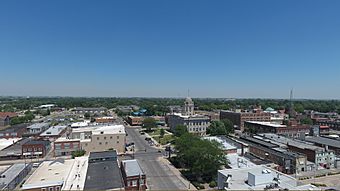Newton Downtown Historic District (Newton, Iowa) facts for kids
Quick facts for kids |
|
|
Newton Downtown Historic District
|
|
 |
|
| Location | Centered around Courthouse Sq. Newton, Iowa |
|---|---|
| Area | 26.4 acres (10.7 ha) |
| NRHP reference No. | 14000665 |
| Added to NRHP | September 22, 2014 |
The Newton Downtown Historic District is a special area in Newton, Iowa, recognized for its important history. It's like a time capsule of buildings that show how the town grew. This district was added to the National Register of Historic Places in 2014. This means it's officially protected and valued for its historical importance across the United States.
When it was listed, the district included 85 important spots. Sixty of these were "contributing buildings," meaning they helped tell the story of the district's past. There was also one "contributing site," which was the courthouse square. The other buildings were not as old or had been changed too much.
Contents
Newton's Early Days and Growth
Jasper County was created in 1846. Newton became the main town, known as the county seat, the very next year. This meant it was the center for government and business in the county.
At first, Newton grew slowly. Businesses mainly served local farmers and the people living in town. They sold supplies and offered services needed by the community.
The Railroad Arrives in Newton
A big change happened in 1867 when the Chicago, Rock Island and Pacific Railroad came to Newton. This railroad connected Newton to other places. It made it easier to transport goods and people.
The railroad helped Newton's economy shift from farming to manufacturing. Factories started to open, and the downtown area grew bigger.
Maytag and Modern Changes
Many washing machine companies started in Newton. The most famous one was Maytag. As Maytag grew into a large company in the mid-1900s, it really changed downtown Newton.
Between 1951 and 1952, 18 businesses updated their storefronts. They changed from older Victorian styles to a more modern look. This modernization continued through the 1960s, giving the downtown area a fresh, new feel.
Buildings and Their Design
Most of the important buildings in the Newton Downtown Historic District were designed by architects from Iowa. However, one famous building, the Hotel Maytag (built in 1926), was designed by Henry Raeder from Chicago.
Many other buildings were designed by local builders. All the buildings in the district are made of masonry, which means they are built with strong materials like brick or stone.
What Were the Buildings Used For?
Most buildings had shops on the ground floor. The upper floors often had apartments or offices. You could also find banks, restaurants, and even the local newspaper office.
The district also included a hotel and places for community groups. Three churches are located here: the Salvation Army, First United Methodist, and First Presbyterian.
Government buildings were also part of the district. These included the old city hall and post office. The current county courthouse, built in 1911, is also a very important building. It is listed separately on the National Register of Historic Places. The area around the courthouse, called the courthouse square, is also a key historical site.



